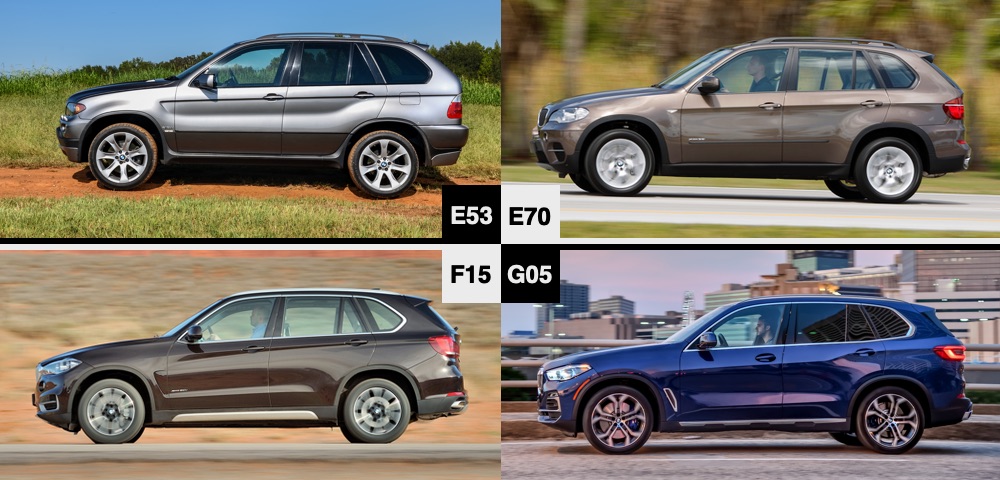BMW X5 Design Review
The Little Wagon That Turned into a Truck
Introduction
In 1999, BMW broke from its history of performance sedans and coupés to launch its first sport-utility vehicle, the X5. BMW refused to call it an “SUV,” and instead coined the term “sport-activity vehicle” (SAV). Regardless of its label, it was a tall, all-wheel-drive vehicle designed to project an image of ruggedness while delivering a satisfying experience on the road.
Mercedes-Benz had done the same two years earlier with the M-class. However, Mercedes did have a previous history of building utility vehicles (the Geländewagen, a.k.a. G-class). That may explain why car enthusiasts from all over the world were pretty receptive at the launch of the Mercedes ML320. BMW was not nearly as lucky: Bimmer fans cringed at the idea of their beloved maker of ultimate driving machines cranking out utility vehicles for which ground clearance and cargo space were just as important as steering feel and throttle response.
As it turned out, the X5 was a hit: it was poorly understood by a few but well received by many, and quickly established its important place in the BMW line-up.
Fast-forward to 2018: BMW offers six SUVs SAVs (X1, X2, … X6) and it has a seventh is on its way (you guessed right, the X7). The trailblazing (sorry, Chevy) X5 is now on its fourth – and new for 2019 – generation. In BMW-speak, the four generations (in chronological order) were the E53 (2000-2006), E70 (2007-2013), F15 (2014-2018) and G05 (2019-present).
We will now take a look at the history of the BMW X5 from a design perspective and see how it has evolved over the years.
Exterior Styling

When BMW designed the first X5, it had no frame of reference or history designing SUVs. Consequently, It is no surprise that its design was derivative of their station wagons of the day. In fact, if you look at the E53 from the waist up and ignore the wheel-to-fender proportions, it very much looks like a station wagon, as shown below in a comparison with the BMW E39 wagon of the same era:
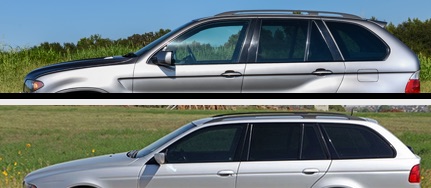
Because of its wagon-esque (and thus car-like) proportions, the first generation of the X5 was dynamic and exciting. The large-diameter wheels and the large wheel wells clearly differentiated from a car, but the greenhouse and high character line that intersected the door handles kept it familiar to the BMW customer base.
Speaking of that character line, in typical BMW 90s fashion, the crease was quite complex, with multiple radii that created an interesting profile made of concave and convex surfaces. That type of surface treatment disappeared in the early 2000s, when BMW introduced its “flame surfacing” design language that replaced these complex creases with simpler yet dramatic lines that were made to look like canvas stretched over a wireframe.
With the E70, BMW took the same design theme but further differentiated it from their car models. Notice how the C-pillar in the E70 is thicker, while the rear quarter panel glass is smaller. This change of glass-to-metal proportion is enough to distance the profile from that of station wagon. BMW also made the fender flares smoother and subtler; that surface treatment toned down the sportiness of the vehicle, while adding substance.
To maximize interior space, BMW elongated the wheelbase. When next to the E53, the E70 feels bigger and bulkier – more truck-like. You can easily notice how, while unchanged in size, the wheels/tires look smaller on the E70; that’s because the entire body grew around it.
At this point, BMW had brought to market a larger X3 that was actually uncomfortably close to the X5 in size – especially interior and cargo volume. The X5 only had one option: to grow bigger. Although only a couple inches longer, the F15 of 2014 was more slab-sided which, combined with a more upright tailgate, gave it a much more substantial and big-SUV feel.
Possibly in an effort to counter its noticeable growth, BMW gave it a door and fender surface treatment that was evocative of the original E53 X5. Notice how the character line on the F15 flows into a “boomerang” shape around the front fenders, cleverly integrated with a functional air scoop that helps extract high-pressure air from the wheel well):

The larger size, combined with styling that was coherent and conservative, catapulted X5 world sales to entirely new levels. The general migration of the market from cars to SUVs was obviously a factor but, by any measure, increasing sales from 100k to 180k units per year is a remarkable accomplishment.
“If ain’t broke, don’t fix it” – says American southern wisdom. Being built in Spartanburg, South Carolina, it was quite à propos that BMW followed that recipe for the F15 replacement: the G05.
In simple terms, BMW took a chisel and sharpened up the edges and corners of the F15 to design the G05. This reflects a general trend in luxury SUV design, possibly led by Cadillac and its successful Escalade: harder edges, chiseled lines – sport brute replaces sport ute. The treatment of the rear quarter panel glass illustrates this move:
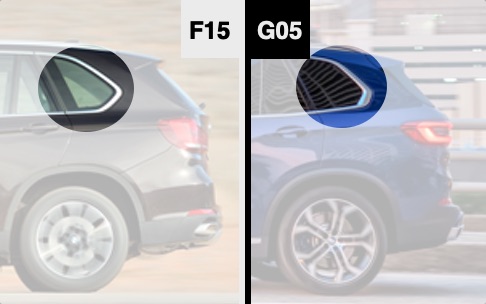
BMW took a page from the E53 design book on the rear fender by incorporating a character line that arcs over the rear wheel well; this graphic element adds a sense of strength and boldness to the side profile, consistent with the “brute” theme.
No BMW design discussion can avoid touching on the defining visual cue of every Bimmer: the kidney grilles. And that is another aspect that clearly illustrates the more angular details of the G05:
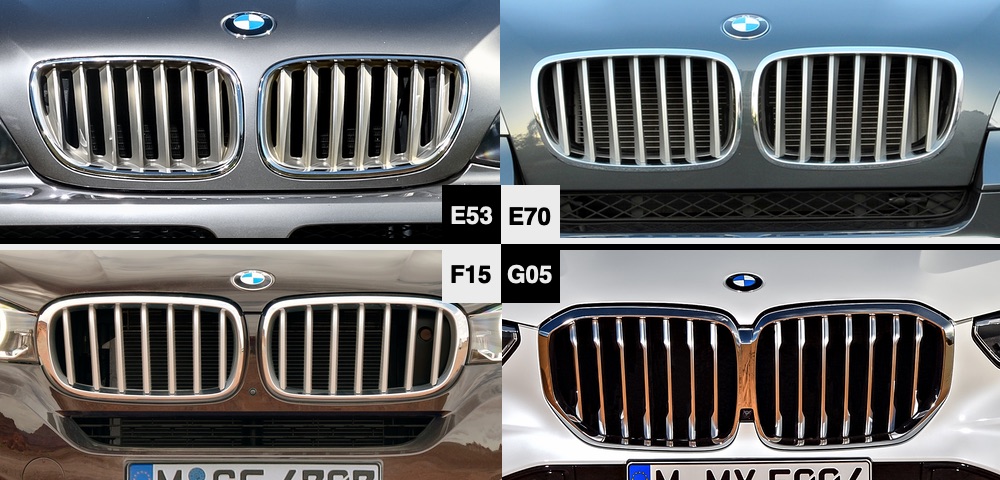
The X5 kidney grille over the years
The grille design remained largely evolutionary through the first three generations (E53, E70 and F15). However, the G05 brought a dramatic change to the traditional grille: edges were sharper, the grille became a single piece with a thick chrome trim connecting both sides, and it became significantly taller.
Interior Design
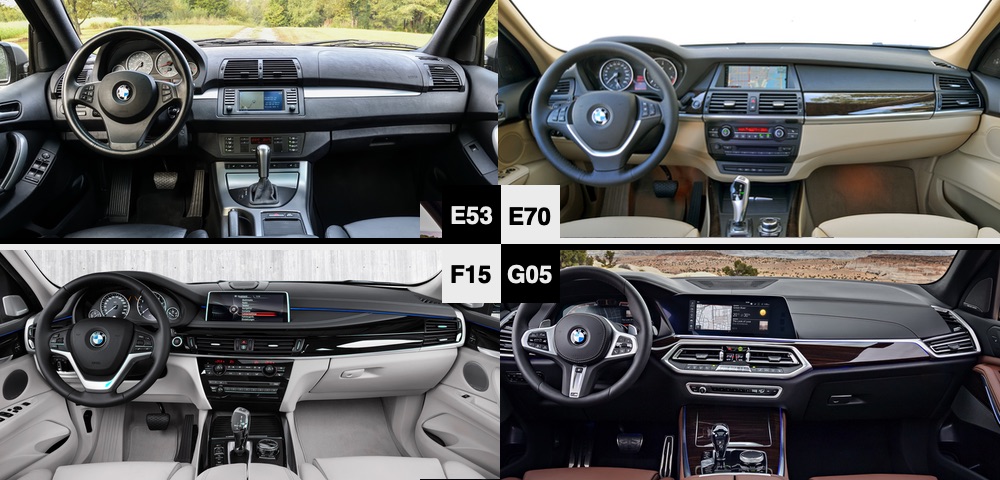
The evolution of the X5 interior is somewhat reflective of its exterior design history. The E53 wasn’t but a variation of the E39 5-series design: the same instrument cluster housed in a binnacle that is clearly separated from the dashboard, and a clear focus on the driver.
As expected from any 90s BMW, the interior was a bit too much business and very little flair, especially in black: a monotonic look with quality materials that appealed to the touch but not to the sight. Some splashes of wood or metal trim spiced up the otherwise dull interior, but every control was logically placed and worked just as one would expect them to. Notice how the GPS was still treated like nothing more than a “big radio,” and it was relegated to a spot between the secondary controls (A/C) and the vents.
With the E70, BMW’s iDrive was a central interface for the vehicle; consequently, it was moved to the top of the center stack and gained a much larger screen. BMW also started to use some metal in combination with leather and wood, giving the interior more texture and color. The instrument cluster was once again lifted from the 5-series (at that point, the E60). During that time, BMW took a minimalist approach to instruments, getting rid of the water coolant temperature gauge and incorporating four instruments into two large dials.
The F15 continued the trend of adding more flair to the interior. The instrument panel now had a combination of metal, leather, wood and lights, creating a richer experience for its occupants. Infotainment also continued to gain space and attention: not only did the iDrive screen get even bigger, but the instrument cluster also saw the addition of a fairly large multi-function screen where navigation, music, telephone and performance information was displayed.
The G05 brings a significant change that is likely here to stay: the fully digital instrument cluster tried to make an appearance years ago (80s and 90s), but ultimately failed to deliver more functionality than tried-and-true analog gauges. However, in the era of infotainment, there is much more to be displayed than measurements. Navigation for example is, by definition, a visual experience. Beyond that, vehicles now have safety and performance capabilities that require a visual representation, such as lane recognition, active cruise, hybrid powertrain, and so much more.

Consistently with the exterior, BMW also made deliberate use of the chisel inside the G05: for example, notice how sharp the corners of the vents are. Metal trim is more present than ever, adding to the premium feel. The seats use more elaborate stitching to convey a sense of workmanship and luxury.
Style Quadrant™
To understand our Style Quadrant, read our article explaining its meaning.
The First Generation (2000-2006): E53
- Innovation: BMW took a different approach from the market with the E53 by designing an SUV that had a strong car DNA. Unlike the Mercedes ML – which looked a bit like a minivan with a nose – the X5 took wagon/hatchback proportions and stretched them onto a truck frame. Unlike the Subaru Outback (and the earlier AMC Eagle), the X5 wasn’t just a jacked-up wagon on bigger tires; it was wagon DNA injected into a truck. For that reason, it scores between Neutral and Fresh on the Innovation dimension.
- Heritage: BMW leaned heavily on its DNA when designing the original X5. From the grille, to the roofline, greenhouse and rear quarter panels, it was unmistakably BMW. It scores Traditional on the Heritage dimension.
The Second Generation (2007-2013): E70
- Innovation: BMW certainly played it safe with the E70. Its profile was more traditional SUV and it did little to differentiate the X5 from general design trends. On the Innovation dimension, it scores between Derivative and Neutral.
- Heritage: BMW continued to stick to its brand image with the E70. It is a traditional BMW design and thus scores Traditional on the Heritage scale.
The Third Generation (2014-2018): F15
- Innovation: although largely derivative, BMW gave the F15 a few innovative touches, such as the use of a functional air extractor behind the front fender. It earns a score between Derivative and Neutral.
- Heritage: no question here, the F15 is a traditional BMW in every aspect.
The Fourth Generation (2019-present): G05
- Innovation: BMW chose a derivative design for the G05. Its sharp edges and bold grille represent the same school as most luxury SUVs, and ultimately it is less discernible from a Mercedes or Audi today than it was in the last generation. The interior design is quite a bit fresher, which pushes the score slightly higher between Derivative and Neutral.
- Heritage: we can see an effort to break from traditional BMW design. That can be seen in the bold grille, the elaborate headlights and tail lights, and the interior. The Heritage score is between Neutral and Disruptive.
Summary: Style Quadrant

The X5 shows an interesting evolution: with an original design that took the traditional BMW DNA and created a fresh interpretation of the SUV, the E53 was an Additive design in that it strengthened the BMW brand by innovating an entire segment. However, the next two generations played it safe, and stuck to tradition and followed the market. Although this is not the recipe for excitement, it is a good recipe for high sales. Today, with the G05, BMW chose to shake the design a bit and step a bit away from its traditional design elements. Unfortunately, it chose a derivative route instead of creating something new in the market. For that reason, the X5 today is a somewhat diluted design that fails to differentiate BMW in the market.

